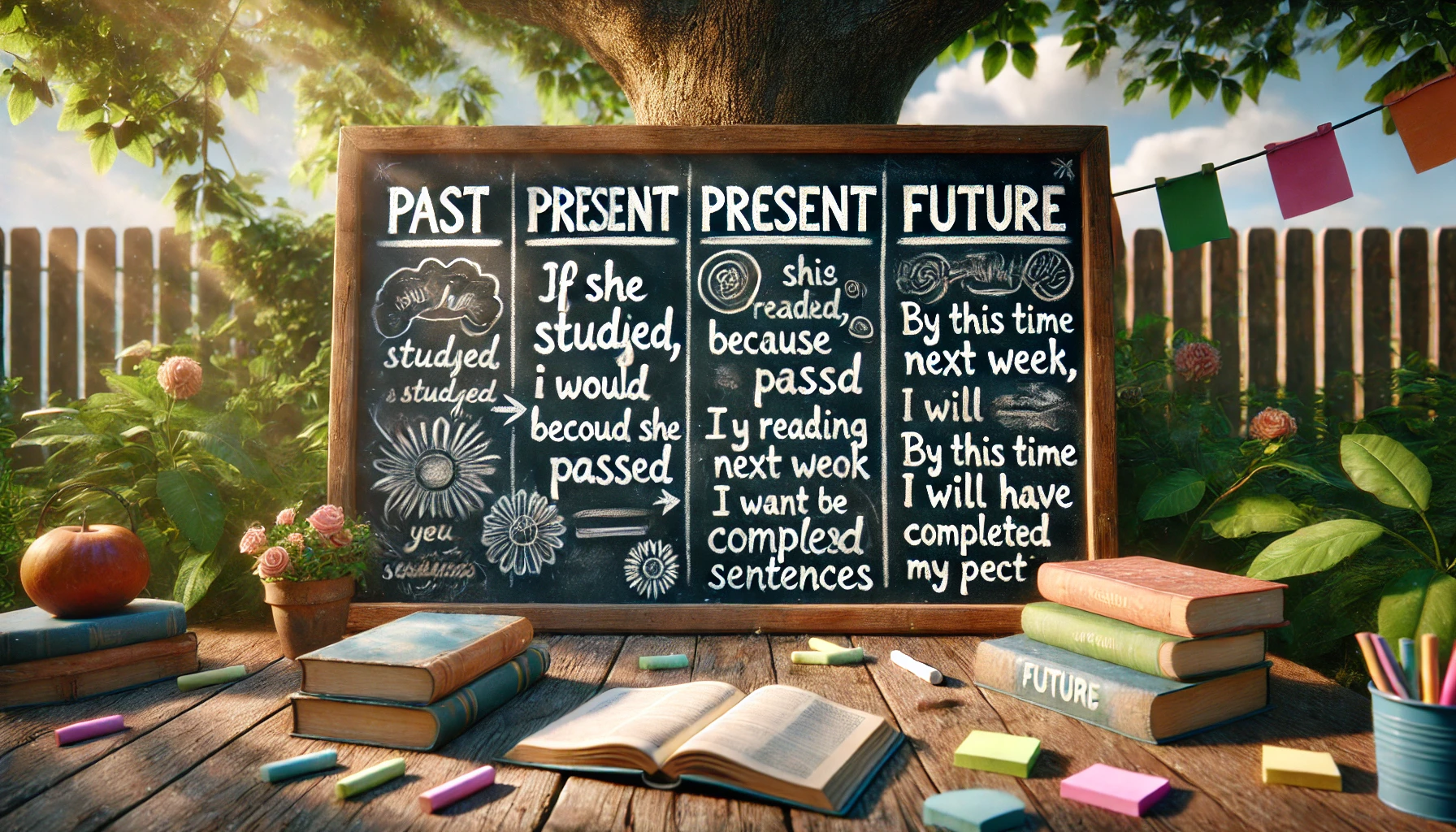Table of Contents
- 1. Introduction
- 2. Understanding the Basics of the Future Perfect Continuous Tense
- 3. Common Uses of the Future Perfect Continuous Tense
- 4. Rules for Forming the Future Perfect Continuous Tense
- 5. Affirmative Sentences
- 6. Negative Sentences
- 7. Forming Questions in the Future Perfect Continuous Tense
- 8. Real-World Examples
- 9. Common Errors and How to Avoid Them
- 10. Conclusion
1. Introduction
The Future Perfect Continuous Tense is an advanced grammatical structure that allows speakers and writers to describe actions that will have been ongoing for a certain period by a specific time in the future. It is invaluable for expressing duration and projecting ongoing actions into the future with precision.
In this comprehensive guide, we’ll explore the rules, uses, and applications of the Future Perfect Continuous Tense, supported by real-world examples and tips to enhance your understanding.
2. Understanding the Basics of the Future Perfect Continuous Tense
The Future Perfect Continuous Tense is used to describe actions that will have been continuing for a duration of time at a specific point in the future. It emphasizes the duration or continuity of the action.
Definition
This tense answers the question, “How long will something have been happening by a certain time?”
Examples:
- “By next year, she will have been working at this company for a decade.”
- “They will have been traveling for hours by the time they reach their destination.”
Key Characteristics
The Future Perfect Continuous Tense stands out for its ability to combine future intent with ongoing action. Here are some key traits:
- Focus on duration: The tense emphasizes how long an action will have been occurring by a specified time.
- Time-bound: It always relates to a specific future point, often indicated with expressions like “by tomorrow,” “by next year,” or “by the time.”
- Ongoing nature: It highlights the continuity of an action rather than its completion.
These features make it an indispensable tool for scenarios requiring precision and time-based projections.
3. Common Uses of the Future Perfect Continuous Tense
The Future Perfect Continuous Tense has specific applications that allow users to describe scenarios with clarity and depth. Let’s explore its main uses:
1. Indicating Duration of an Ongoing Action Before a Future Event
This tense is commonly used to show how long an action will have been in progress by a certain future time:
- “By 8 PM, they will have been studying for five hours.”
- “She will have been living in New York for a decade by next summer.”
2. Highlighting Cause-and-Effect Relationships
The tense is also useful for explaining the anticipated outcome of an ongoing action:
- “By the end of this year, the company will have been implementing its new policies for six months.”
- “The athlete will have been training for weeks, which explains their readiness for the event.”
3. Making Predictions About Future Situations
It allows speakers to predict future scenarios based on ongoing actions:
- “By the time the guests arrive, we will have been cooking for hours.”
- “She will have been preparing for the presentation, so she’ll be well-prepared.”
4. Rules for Forming the Future Perfect Continuous Tense
To use the Future Perfect Continuous Tense correctly, it’s crucial to understand its structure. This tense combines elements of future intent, continuity, and duration.
Structure
- Subject + will + have + been + present participle (verb + -ing)
Examples:
- “We will have been working on this project for three months by the time it’s completed.”
- “He will have been driving for six hours by the time he reaches his destination.”
The auxiliary verbs ‘will have’ indicate future certainty, while ‘been’ and the present participle emphasize the continuity of the action.
5. Affirmative Sentences
Affirmative sentences in the Future Perfect Continuous Tense highlight ongoing actions that will continue up to a specific point in the future. These sentences are straightforward and often include time expressions like “by,” or “for.”
Structure of Affirmative Sentences
The structure is:
- Subject + will + have + been + present participle
Examples:
- “By next month, she will have been teaching at this school for five years.”
- “They will have been running the business successfully for over a decade.”
- “We will have been waiting for the train for 30 minutes by the time it arrives.”
These sentences clearly convey the continuity and duration of an action up to a future moment.
6. Negative Sentences
Negative sentences in the Future Perfect Continuous Tense indicate that an action will not have been ongoing up to a specific point in the future. The word ‘not’ is inserted after ‘will’ to form the negative structure.
Structure of Negative Sentences
The structure is:
- Subject + will + not + have + been + present participle
Examples:
- “By 2025, we will not have been working on this project anymore.”
- “She will not have been studying for long when the exam begins.”
- “They won’t have been living here for a year by the time they move.”
7. Forming Questions in the Future Perfect Continuous Tense
Questions in this tense are used to inquire about the duration of an action that will be ongoing up to a specific future point. They can take the form of yes/no questions or Wh-questions.
Structure of Yes/No Questions
The structure is:
- Will + subject + have + been + present participle?
Examples:
- “Will she have been working on the report by tomorrow?”
- “Will they have been traveling for hours by the time they arrive?”
Structure of Wh-Questions
For Wh-questions, the question word comes first, followed by the auxiliary verbs ‘will,’ ‘have,’ and ‘been.’
- “How long will you have been studying by the end of the semester?”
- “What will they have been doing during the meeting?”
8. Real-World Examples
The Future Perfect Continuous Tense is widely applicable in real-world scenarios. Here are some examples categorized by context:
In Daily Conversations
- “By the time you get home, I will have been cooking dinner for an hour.”
- “She will have been reading that book all afternoon.”
In Professional Settings
- “By next quarter, the team will have been testing the new software for six months.”
- “The company will have been operating in this market for 10 years by then.”
In Academic Writing
- “By the end of this study, researchers will have been analyzing the data for over two years.”
- “The students will have been preparing their final projects for months before the presentation.”
9. Common Errors and How to Avoid Them
Using the Future Perfect Continuous Tense correctly can be challenging for learners. Here are some common pitfalls and strategies to avoid them:
Error 1: Omitting Auxiliary Verbs
Incorrect: “I been working here for years.”
Correct: “I will have been working here for years.”
Always include ‘will have been’ to form the correct structure.
Error 2: Misplacing Time Expressions
Incorrect: “By next week, I will working here for a year.”
Correct: “By next week, I will have been working here for a year.”
Ensure the verbs align with the auxiliary verbs to maintain grammatical accuracy.
Error 3: Confusing It with Other Future Tenses
Incorrect: “They will be working here for 10 years by next month.”
Correct: “They will have been working here for 10 years by next month.”
Distinguish this tense by focusing on duration and continuity in the future.
10. Conclusion
The Future Perfect Continuous Tense is a powerful tool for describing actions that will have been ongoing up to a specific point in the future. Its unique focus on duration and continuity makes it invaluable for projecting actions and understanding cause-and-effect relationships.
By mastering the structure, uses, and common applications of this tense, you can enhance your grammar and writing skills significantly. Practice forming affirmative, negative, and interrogative sentences, and experiment with real-world scenarios to deepen your understanding.
Start applying the Future Perfect Continuous Tense in your conversations and writing today, and watch your language skills reach new heights!




